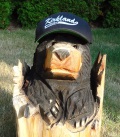Umpiring Advanced Techniques Video
Requesting help and responding to a checked swing
Plate Umpire: To ask for help on a checked swing, point to the Base Umpire with your left hand / finger and shout “Did he go?!”
- From behind home plate, it can be difficult to determine whether to call a ball or strike on a checked swing. If the Base Umpire is on the first (for a right handed batter) or third base (a left handed batter) line, you should ask him to make the call. At these positions, he’ll have a better view to judge whether the batter halted his swing sufficiently. If the Base Umpire is in the middle of the field (B or C slots), you’ll have to decide whether to call a ball or strike on a checked swing.
- The defense, typically the catcher or Manager, can also ask (appeal to) the Plate Umpire for help on a checked swing. Appeals on a checked swing must be made before the next pitch.
- An appeal on a checked swing can only be made after a pitch that was called a ball. A strike call by the Plate Umpire cannot be appealed or changed.
- To ask for help on a checked swing, point to the Base Umpire with your left hand / finger and shout “Did he go?!”
Base Umpire: Adopt your own visual cues for deciding between a strike or ball. Then make your call using the strike and ball arm/hand signals and verbally.
- Deciding whether a ball or strike after a checked swing is not straight forward because there’s no definitive rule for how far the swing has to travel. It is a judgement call. Did the batter "strike at" the pitch? Or did he interrupt his swing in time?
- Each umpire will adopt his own visual cues. Traditionally, it is thought to be the halfway point of a swing. If the barrel of the bat passed over the back of home plate, you likely have a strike.
- Make your call using the strike and safe arm/hand signals and verbally. For a strike – “He went!” For a ball – “no, he didn’t go!”
Back to: Umpire Communications

